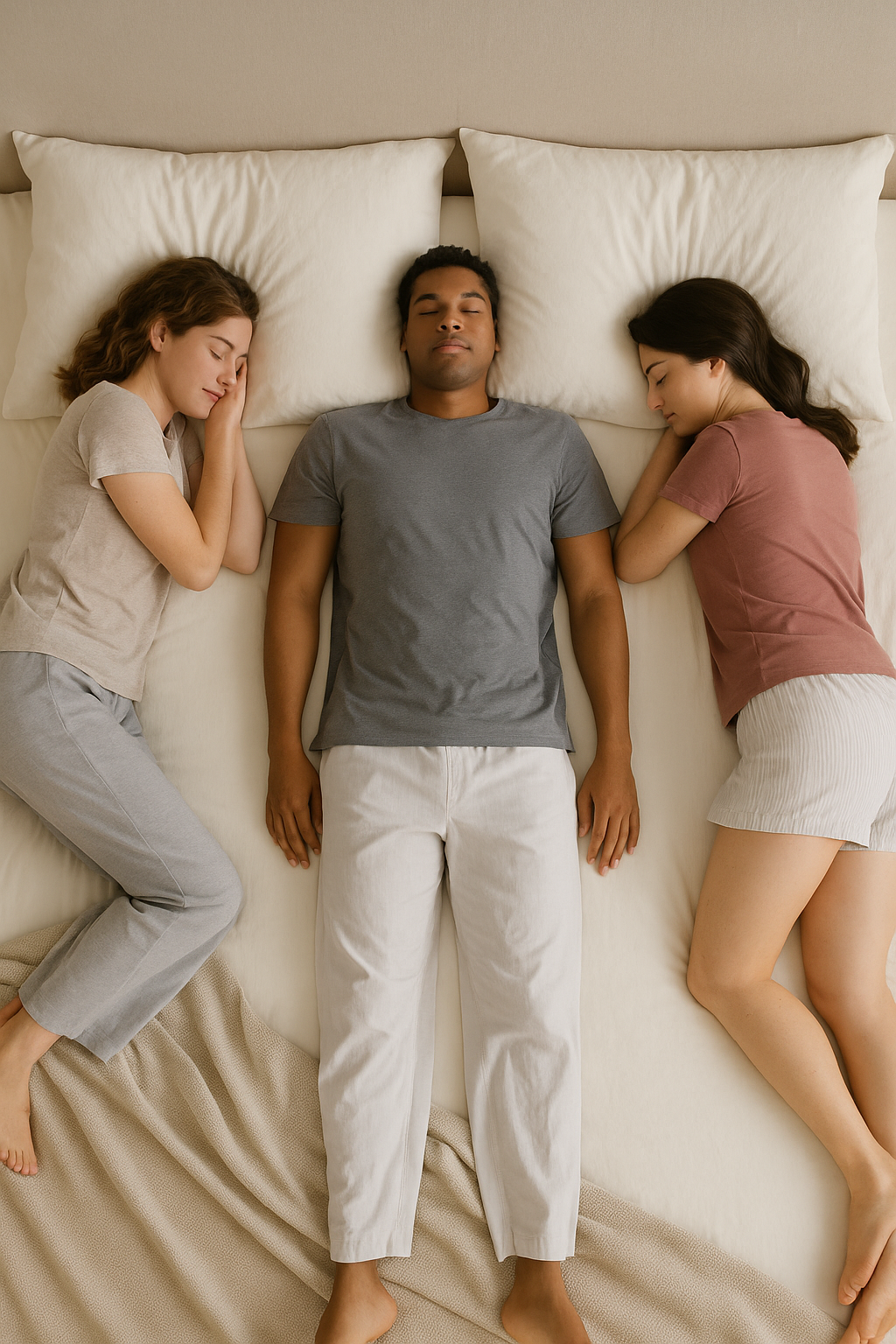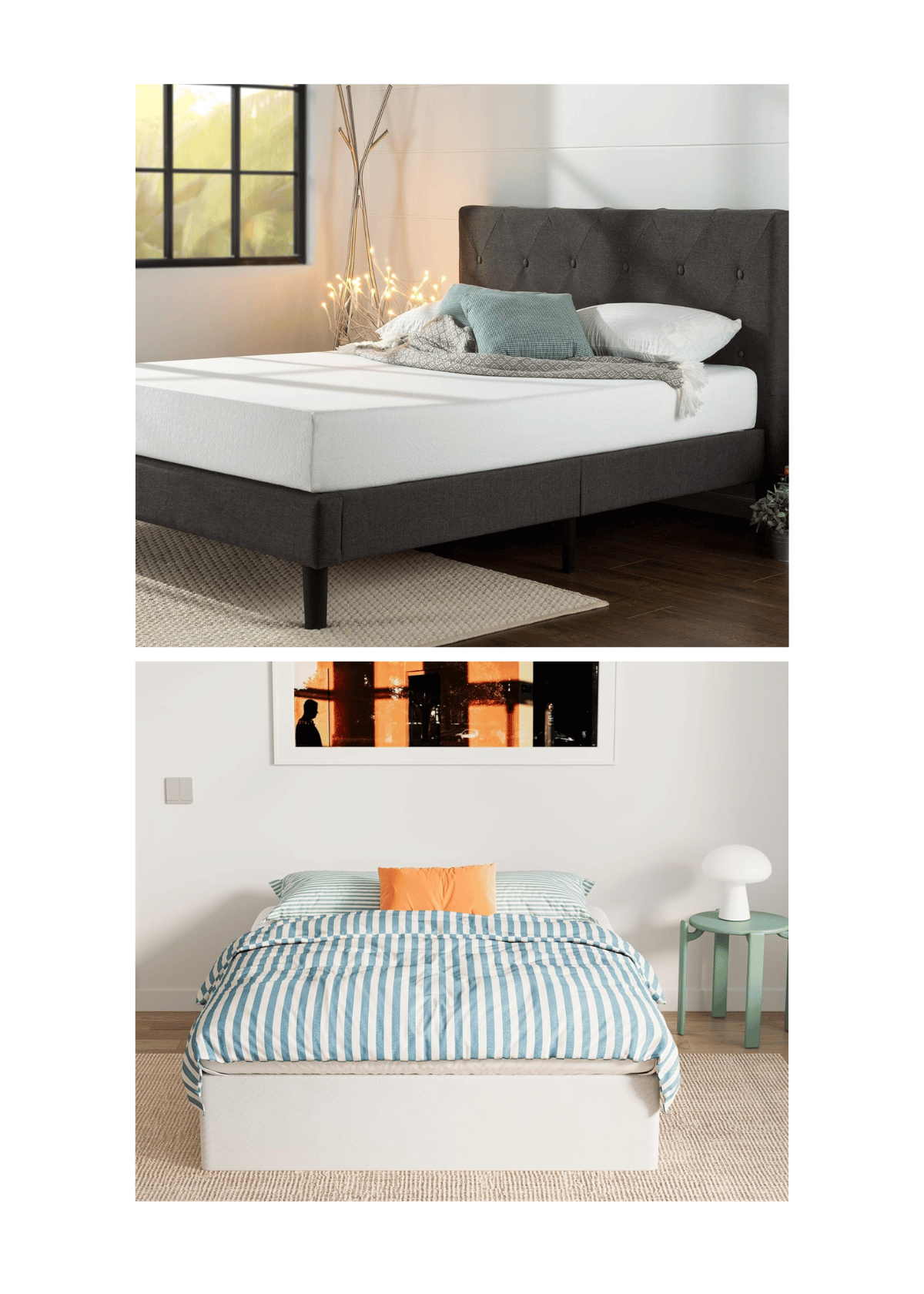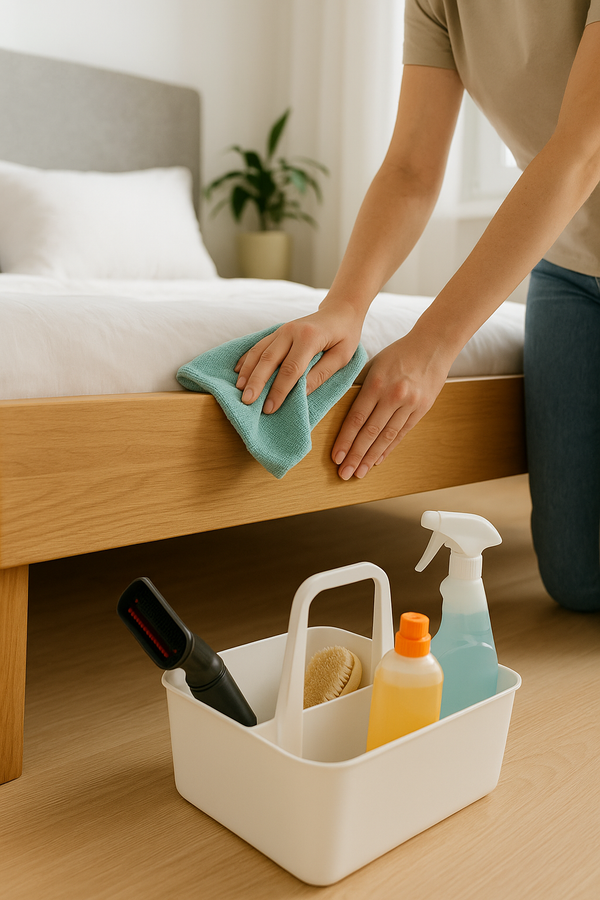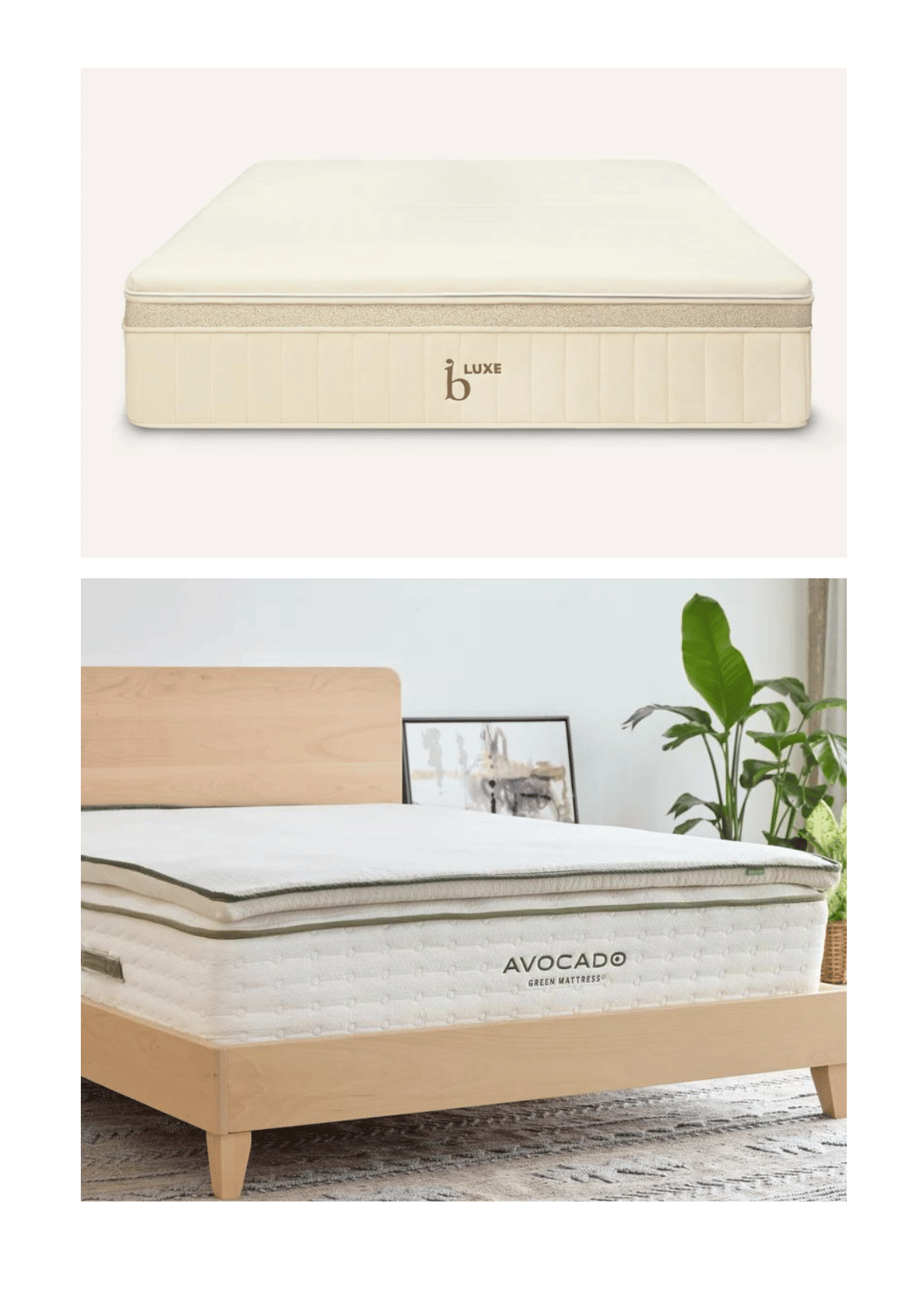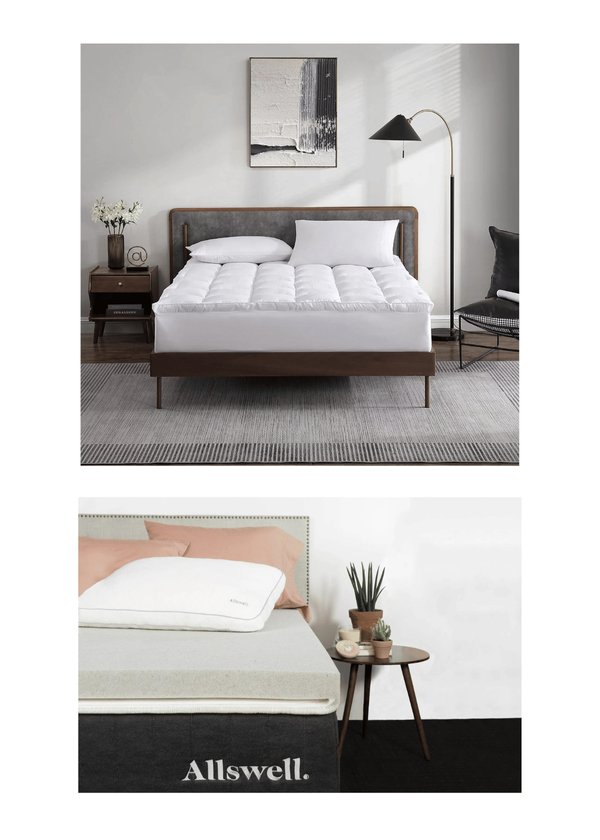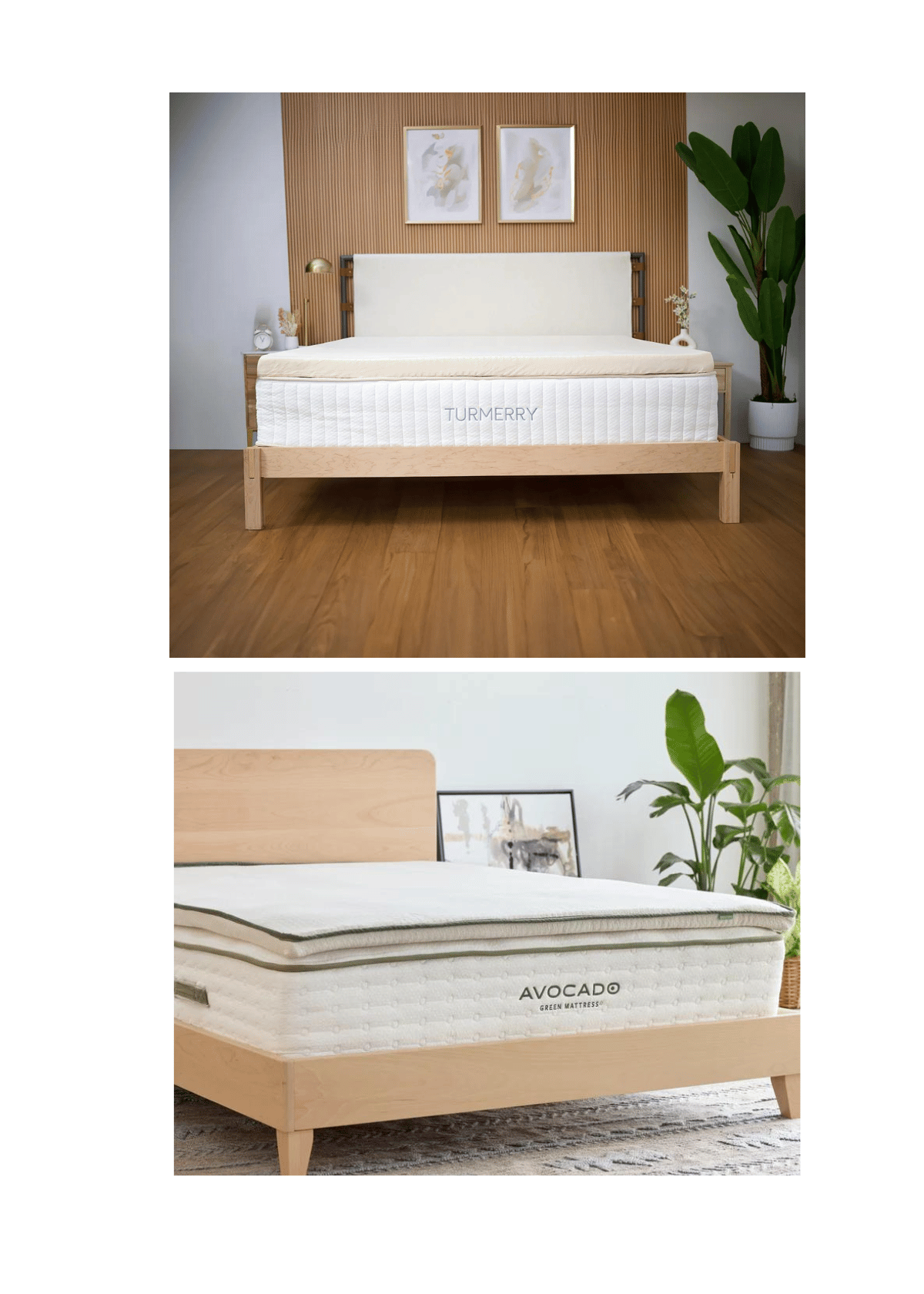(Last Update: 10/25/2025)
Did you know your sleep position can significantly impact your health, comfort, and sleep quality?
Choosing the right mattress from top-rated mattress companies based on your preferred sleep position could be the key to unlocking a rejuvenating and good night's sleep.
In this guide about "sleep positions and mattress preferences," we'll delve into the world of resting postures, mattress types, and shopping tips to help you make an informed decision and enhance your sleep experience.
Short Summary
- Understanding bedtime positions and their effects on overall well-being is essential for improved sleep quality.
- Different mattress types are better suited to the sleeping side, back, and stomach. Many foam mattresses offer comfort but may not suit combinations or heavier-weight individuals.
- When selecting a mattress, consider body weight, pressure relief, temperature regulation & company policies/reputation before trying it out as a couple to ensure the best purchase experience.
Understanding the Ideal of the Sleep Position and Its Effects on Your Sleep and Health

Resting postures and positions can have a profound impact on your overall well-being. Each position has unique effects on health and comfort, with side sleeping being the most popular, accounting for around 41% of individuals.
However, back and stomach sleeping positions can also be beneficial or detrimental, depending on age, health, and specific medical conditions.
- The selection of a suitable mattress is crucial for improved sleep quality. A poorly chosen mattress can lead to back, joint, and neck pain, irritability, fatigue, and other adverse effects.
- Understanding the best mattress firmness for your resting postures is essential. Moreover, sleeping face up can sometimes worsen the pain for sleepers with neck pain—factors like body weight and individual preferences.
Your preferred sleeping position directly impacts your spinal alignment, blood flow, and overall sleep quality. Back sleepers often enjoy a neutral spine posture that helps prevent lower back strain, while side sleepers benefit from enhanced pressure relief at key pressure points.
Stomach sleepers, however, may need firmer mattress options to avoid neck tension and improper spinal curvature. Good sleep isn’t just about comfort—it’s about physical health and support needs that match your body weight and sleeping habits.
Sleep positions influence mattress preferences more than most people realize. Many people seek enough support for the lower back, while others want a bouncier feel that feels comfortable for different positions.
The right mattress provides adequate support and promotes healthy circulation, helping your body feel rejuvenated each morning.

🛌 Sleep Positions & Mattress Alignment
Choosing the right mattress can depend heavily on how you sleep, as explained in Tom’s Guide: How to Choose a Mattress for Your Sleep Position, side sleepers need pressure relief, back sleepers require balanced support, and stomach sleepers benefit from firmer surfaces for proper spinal alignment.
1. Sleeping on Your Side
Side sleeping is the most common position, accounting for approximately 41% of individuals. This position can alleviate stress on the back and hips, reduce heartburn, and enhance spinal alignment. For optimal comfort, side sleepers should consider a mattress that offers pressure relief, particularly around the shoulders and hips.
According to Forbes, Memory foam or pillow-top mattresses are generally recommended for side sleepers, as they provide the necessary contouring to maintain a neutral position and support the spine's natural curvature.
Real-life challenges are explored in Sleep Position Dilemma for New Mattress on the Mattress Underground forum. Sleepers who shift between positions often struggle with finding the right feel. A mattress with a thin comfort layer and responsive base can relieve pressure while maintaining support during position changes.
Different sleeping positions influence not only comfort but long-term health benefits. For instance, many side sleepers experience better spinal alignment, while sleeping on your stomach can strain the lumbar region.
A systematic review of sleep studies shows that older adults tend to shift toward back sleeping for extra support and better weight distribution.
Choosing the right sleep posture isn’t just personal—it can affect how well you sleep and feel in the long run.
Different firmness levels cater to different preferences and comfort zones. The most important factors for most people are balanced cushioning, body alignment, and pressure relief to get a good night's sleep.
Side sleepers
Side sleeping is the most common position, where one lies on their side with legs extended and arms bent in front of them.
To avoid shoulder pain, a side sleeper should use a supportive pillow, maintain proper spinal alignment, and consider using a body pillow.
- This position alleviates stress on the back and hips, reduces heartburn, maintains proper spinal alignment, and enhances optimal nerve functioning.
- It also helps to diminish breathing difficulties that cause snoring and reduce sleep apnea symptoms, making it a popular choice for those seeking a good night's sleep.
- Regarding mattress selection, side sleepers should opt for a soft mattress with a softer feel.
- For those who prefer air mattresses, a medium firmness of 4 to 6 on the firmness scale should do wonders. Softer mattresses assist in alleviating pressure at crucial points, such as the shoulders and hips.
- Memory foam or a pillow-top softer mattress are generally recommended for side sleepers, as they offer the most pressure relief.
Most people find side sleeping to be the most comfortable, especially when paired with the best mattress designed for this posture.
Soft-to-medium comfort layers help cradle the shoulders and hips, reducing pain in pressure-prone areas. Since this is the most common sleeping style, many mattress brands offer targeted support for this posture.

Back Sleeping
Back sleeping is the best for maintaining healthy spinal alignment and ensuring adequate respiration.
- This position helps keep the hips and spine aligned, reducing too much pressure on the joints and promoting good posture.
- Back sleeping benefits our skin as it eliminates friction between the face and the soft pillow case, reducing wrinkles and acne.
- Medium-firm beds, ranging from 5-7 on the firmness scale, are suggested for back sleepers who need to avert back pain.
However, back sleeping is not recommended for those with GERD, acid reflux, sleep apnea, snoring, or pregnancy due to the potential health risks associated with this position.
This position supports natural alignment of the lumbar area, and scientific data suggests it may be ideal for those experiencing lower back pain—especially when combined with a medium-firm mattress.
Stomach Sleeping
Stomach sleeping, though not as common as side or back sleeping, involves lying on the abdomen with the head turned to one side.
- This position can strain the spine, resulting in back and neck pain. Therefore, choosing the best sleep position and firm mattress is essential to minimize these risks.
- A firm hybrid or foam mattress with a firmness level of 7 or 8 (or 6 for lighter sleepers) is typically the most optimal choice for stomach sleepers.
Minimal sinkage is crucial for stomach sleepers, as it helps maintain proper spinal alignment and prevent discomfort.
As the least common position, sleeping on your stomach can put stress on your neck and compress the spine. Extra support in the form of a firmer surface helps keep the torso elevated to protect the lumbar region. For those unwilling to switch to other positions, it’s crucial to choose a mattress that minimizes spinal sinkage.
People who rotate through multiple positions need a responsive mattress that adjusts quickly without sagging.
Those who favor just one position, like sleeping on your stomach, require targeted extra support in the lumbar area to prevent long-term misalignment.
Scientific data indicates that a misaligned spine during sleep can lead to cumulative discomfort and tension across the lumbar region, especially for older adults and people with back sensitivity.
How Sleep Positions Influence Sleep Quality and Health
Each sleep position offers unique benefits and challenges. Side or stomach sleepers experience pressure buildup along the hips and shoulders, requiring supportive foam layers or innerspring coils for balance. Back sleepers, on the other hand, rely on optimal support that prevents sinking while maintaining proper spinal alignment.
- Side sleepers: look for softer surfaces with cushioning to protect joints.
- Back sleepers: choose a medium-firm mattress that offers sufficient support and motion isolation.
Stomach sleepers: benefit from firmer mattress types that keep the body level and prevent face-down compression. The right mattress selection minimizes discomfort and contributes to long-term health.
Considerations for Hot Sleepers
TEMPERATURE REGULATION
Hot sleepers should look for mattresses designed with cooling technologies. Options like the Helix Midnight Luxe with GlacioTex Cooling Cover or the Purple Mattress with GelFlex Grid are tailored to dissipate heat and maintain a comfortable sleeping temperature.
Body type also plays a role here. Heavier individuals may trap more heat in foam layers, while lighter sleepers may feel cooler regardless of materials.
Memory foam mattresses often retain heat, whereas latex mattresses offer better airflow. Other sleeping positions can affect temperature too; side sleepers have more skin contact with the mattress surface.
🔄 Adapting to Changing Sleep Habits
CHANGING POSITIONS
It's common for people to change positions during sleep. A mattress with a coil spring base can provide the necessary support and responsiveness to accommodate movement, ensuring proper alignment throughout the night.
Switching from one position to multiple positions during the night is natural and often linked to changes in health, body shape, or aging. A mattress that accommodates different sleeping positions offers more long-term versatility.
Choosing the Right Mattress Based on Your Sleep Position
Selecting a suitable mattress based on your position is essential for optimal comfort and support. Sleeping position can affect the detoxification process. Lying on your left side enhances lymphatic drainage.
Sleeping on a proper mattress plays a significant role, too. An uncomfortable mattress might lead to restless sleep, affecting the body's recovery and body’s natural detoxification process.
A suitable mattress provides your body with the necessary support and comfort to maintain an optimal position, aiding the detox process.

Navigating Mattress Companies
Choosing the Right Brand
Many mattress companies offer a variety of options tailored to different sleeping habits and preferences. When selecting a mattress, consider
Different mattress classifications cater to side, stomach, and back sleepers' unique needs, ensuring a restful night's sleep.
Before purchasing your next bed, you must know how the mattress feels. Spend time lying in various sleeping positions, checking comfort and contouring. Assess firmness, ensuring it doesn't sag, supports your spine, and suits your weight and sleep habits. If shared, evaluate motion transfer.
Foam beds are best suited for side sleepers, relieving cushioning and pressure points in critical areas. On the other hand, an innerspring mattress is ideal for back sleepers and helps to avoid back pain due to its firmer feel and support. Stomach sleepers can benefit from a latex mattress, which offers a balance of comfort and support.
🛏️ Mattress Features for Optimal Comfort
Pressure Relief
A mattress that helps relieve pressure points is crucial for preventing discomfort and promoting restful sleep. Materials like memory foam can conform to the body's shape, distributing weight evenly and reducing stress on sensitive areas. Nolah Mattress+9Mattress Firm+9Tom's Guide+9Wikipedia
SPINE ALIGNMENT
Maintaining the spine's natural curvature during sleep is essential for avoiding back pain. An ideal mattress s
For combination sleepers, hybrid mattresses provide a responsive and versatile option, catering to the needs of various sleeping positions.
Your mattress should complement your preferred sleeping position and body type. For side sleepers, hybrid or memory foam beds with contouring comfort layers reduce pressure points and improve sleep quality.
Back sleepers should seek balanced firmness to maintain posture, while stomach sleepers achieve better results with a firmer mattress that avoids sagging.
Factors like body weight, underlying support, and responsiveness determine how a mattress feels and performs.
- Lighter individuals: softer beds with adaptive foam layers.
- Heavier sleepers: firmer mattresses with strong core support.
WHAT YOUR MATTRESS TYPE SAYS ABOUT YOUR SLEEPING STYLE
Your mattress preference often reflects your sleep habits. Memory foam mattresses are favored by people who seek contouring and relief in the shoulders and hips—ideal for side sleepers.
In contrast, innerspring mattresses provide bounce and are more breathable, suiting those who toss and turn or sleep hot. If you switch between other sleeping positions, you may prefer a hybrid mattress that merges responsiveness with contouring.
Meanwhile, latex mattresses appeal to those who prioritize sustainability, allergy resistance, and firm support. They’re often a great match for those with spinal sensitivity or heavier body types needing reinforced weight distribution.
The comfort layers in these mattresses help with reducing pain across the lower back, especially if you suffer from stiffness in the morning.

Memory Foam Mattresses
- There may be better choices than memory foam beds for combination sleepers, as the contouring benefits ideal for side sleepers can impede movement and make it difficult to switch positions.
- Additionally, heavier stomach or back sleepers should avoid memory foam beds, as they may not provide adequate support.
- However, there are firmer foam beds suitable for stomach sleepers.
These mattresses offer the necessary support to keep the spine aligned and prevent the hips and belly from sinking too deeply, which can cause discomfort and back pain. Brands like Tempur-Pedic, Casper's Original Foam, and Plank by Brooklyn Bedding offer firmer foam beds that could suit stomach sleepers.

Innerspring Mattresses
Innerspring mattresses are a popular and cost-effective option, providing a firmer feel ideal for back and stomach sleepers with back pain.
- Modern innerspring beds come with additional support layers of cushion on the back sleeper comfort layer above the springs, providing a soft feel for side and lighter-weight sleepers.
- An innerspring mattress can feature either a continuous or pocketed coil system. Coils Individually pocketed, also known as pocket springs or Marshall coils, are a type of coil used in innerspring mattresses.
- Continuous coil systems are interconnected, making motion transfer isolation between sleepers difficult, while pocketed coil systems offer undisturbed sleep at a slightly higher cost.
Latex Mattresses
Latex mattresses are constructed from natural latex derived from rubber tree sap, making them more durable and organic than other mattress types.
- They are cooler and more adaptive than most memory foam mattresses, responding to body movements while isolating motion.
- Due to their balance of comfort and support, latex mattresses are suitable for all sleepers, including stomach sleepers requiring a firmer mattress surface to maintain proper spinal alignment.

Hybrid Mattresses
A Hybrid mattress combines the benefits of innerspring support and foam or latex comfort layers, offering a balance of firm support and plush comfort.
- They facilitate air circulation and provide a more robust structural support system than a solid foam mattress, making them suitable for different sleeping positions, particularly side sleepers.
- Combination sleepers can benefit from hybrid mattresses, as they are softer and more responsive due to the combination of an innerspring mattress for support and polyurethane foam or even latex foam and comfort layers.
- Polyurethane foam is commonly used in many cheaper mattresses due to its affordability and ease of production.
- This type of foam is versatile and can provide reasonable comfort and support.
While one’s sleeping style may dictate certain features, it's also wise to account for movement. People who sleep in multiple positions throughout the night need a mattress that balances contouring and responsiveness.
Hybrid mattresses are a great fit for these individuals because they combine pressure relief with bounce.
Mattress Firmness Levels Explained: Finding the Perfect Match
Firmness plays a crucial role in achieving quality sleep. The firmness scale, usually ranging from plush to extra firm, helps sleepers find the perfect mattress feel. A medium-firm mattress often suits most people, balancing comfort and adequate support. Firmer models enhance spinal alignment for stomach sleepers, while softer options cushion side sleepers’ shoulders and hips.
- Plush: contouring comfort and enhanced pressure relief.
- Medium firm: balanced feel, suitable for most sleeping positions.
Firm: optimal support for heavier body weights or stomach sleepers. Selecting the right firmness level is about personal preference and recognizing how your mattress affects your sleep, posture, and comfort.
Factors to Consider When Choosing a Mattress
When choosing the perfect mattress, it's essential to consider factors such as physical weight, pain and pressure relief, and temperature regulation. Each of these factors can significantly impact the comfort and support of your mattress and, ultimately, the quality of your sleep.
In addition to these factors, it's crucial to consider your partner's preferences and the company's policies and reputation when shopping for a mattress. This Attribute ensures a satisfactory purchase and a comfortable sleeping experience for you and your partner.
Shopping Smart for Your Ideal Mattress
Online shopping makes it easier to compare options and discover what feels right. A medium-firm model is often a great option since it offers enough support for many people’s sleeping habits.
Body Weight
Body mass plays a significant role in determining the ideal mattress's firmness and support.
- Individuals of a lighter weight typically prefer a softer bed, while those of an average or greater weight are generally more comfortable on medium-firm and firm beds.
- Shorter, typically thinner mattresses, like bunk or trundle beds, can be ideal for space-saving needs but may compromise comfort and durability.
- In contrast, taller mattresses, with additional layers, often offer enhanced comfort, support, and longevity,
Lighter individuals may find soft to medium-firm beds more suitable, while heavier individuals may require the added sturdiness of coils underneath the foam to avoid back pain.
- Match mattress firmness to your body type and preferred sleep position
- Look for enhanced lumbar support if you suffer from lower back pain
- Consider the thickness and quality of comfort layers for pressure relief
- Choose mattresses with breathable materials if you tend to sleep hot
- Evaluate how well the mattress supports weight distribution across the body
Durability is of utmost importance to sleepers with higher physique weight, as they can cause more wear in the soft beds and the top layers of a mattress. Higher body mass people often require a mattress with a thicker comfort layer. Such mattresses commonly make use of higher-density materials.

PAIN AND PRESSURE RELIEF
Pain and pressure relief is essential to choosing the ideal mattress, as it can significantly impact your sleep quality and overall well-being.
However, medium-firm mattresses are recommended for individuals with chronic back and neck pain. Those suffering from neck and back pain should ensure adequate spine support to alleviate discomfort.
Individuals with musculoskeletal pain may find relief with medium-firm foam mattresses, as they can alleviate pain and expedite the time to fall asleep. Selecting a mattress that provides proper support and pressure relief is crucial to achieving a comfortable and restful night's sleep.
Choosing the right mattress involves more than just comfort. Important factors include firmness level, temperature regulation, motion isolation, and edge support. The mattress core—foam, latex, or supportive innerspring coils—determines how well it aligns with your body’s natural curve. Look for quality sleep indicators such as consistent support and pressure relief across all sleeping positions.
- Temperature control for hot sleepers.
- Edge reinforcement for stability and durability.
Material performance for longevity and responsiveness. Considering these variables ensures better sleep quality and reduces body strain over time.
Special Considerations for Health Conditions and Sleep Apnea
Health conditions influence how a mattress should feel and function. Sleep apnea sufferers, for example, often find relief using adjustable bases that raise the head slightly, Side sleeping positions can also reduce snoring and breathing interruptions.
Those with back pain benefit from firmer support and targeted comfort zones that ease lower back tension. Consulting healthcare professionals helps determine the best mattress for your unique needs.
Good sleep plays a vital role in overall health, helping restore muscles and support recovery. A mattress that offers enhanced pressure relief and alignment reduces stress on key pressure points.
WHY MATCHING MATTRESS TO BODY TYPE MATTERS
Your body type affects how you experience firmness and pressure relief. Lighter sleepers under 130 pounds often don’t compress dense foam enough to access deep contouring, so they may prefer softer comfort layers.
Conversely, heavier individuals tend to sink deeper into a mattress and may need firmer layers for extra support, especially in the lumbar region.
A small study from sleep ergonomics experts revealed that improper mattress firmness based on body type increased reports of discomfort in the lower back and shoulders. For older adults, choosing a mattress that provides stability and minimizes motion transfer can help prevent aches in the long run.
Generally speaking, people with broader hips or shoulders should prioritize pressure-relieving materials to support their curves.
TEMPERATURE REGULATION
Temperature regulation is a vital factor in the mattress temperature and ensures an optimal sleep experience for those who sleep hot. A mattress that retains heat can cause discomfort and disrupt sleep. In contrast, a mattress that promotes airflow to regulate mattress temperature and maintains a more comfortable sleeping temperature can enhance sleep quality.
When shopping for a mattress, consider cooling features that help regulate temperature and maintain an ideal sleeping environment.
Customer reviews can offer valuable insights into the efficacy of these cooling features, allowing you to make an informed decision and choose a mattress that promotes a comfortable and refreshing sleep experience.
When evaluating your current mattress, you may notice uneven wear or lack of support in the lower back or shoulders. Zoned mattresses help solve this problem by reinforcing the lumbar area with firmer foam or coils while offering softer zones near the hips and shoulders.
These features enhance weight distribution and alignment, especially for people with distinct body types. Generally speaking, this makes a substantial difference for sleepers dealing with lower back pain or tension in the neck. Targeted zones can also make other sleeping positions more comfortable.

Mattress Shopping Tips
Knowing how your body type and sleeping style interact can give you a better idea of which mattresses to test in-store. Trying a floor model lets you assess how the comfort layers respond to movement and support your preferred sleeping posture.
Now that you know sleeping positions, mattress types, and factors to consider when choosing a mattress, it's time to explore some practical shopping tips. These tips include trying the mattress before purchasing, considering your partner's preferences, and evaluating company policies and reputation.
TRYING BEFORE BUYING
- You can try a mattress before you purchase. It is essential to meet your comfort and support needs. Testing a mattress in-store can help you avoid the inconvenience of returning a mattress unsuitable for you.
- If you purchase a mattress online, use the trial period to evaluate the bed. This option allows you to assess the mattress in your environment and ensure it provides the comfort and support you require for a restful sleep.
QUICK TIPS FOR SMARTER MATTRESS SHOPPING
- Try to test a floor model in-store or use a free trial offer
- Compare company policies: look for free returns, long warranties, and sleep trials
- Know your body type and how it affects firmness preferences
- Assess if the mattress aligns with your current sleep habits and potential changes
- Compare mattress specs—don’t assume higher price = more comfort
- Seek guidance from a veterans service officer or health provider if buying for medical needs.
Shopping for a mattress today involves a blend of research, testing, and online convenience. Evaluate product materials, reviews, and trial options before buying. Most brands now provide free returns, extended warranties, and risk-free sleep trials—ideal for ensuring you find the right mattress without pressure.
- Test firmness and responsiveness in person when possible.
- Compare online reviews for insight into real user experiences.
Consider your support needs and preferred sleeping position. These simple strategies help you select a mattress that balances quality, performance, and personal comfort preferences.
CONSIDERING YOUR PARTNER'S PREFERENCES
When shopping for a mattress with your partner, it's essential to consider both your sleeping requirements and preferences.
Couples should consider factors such as budget, mattress firmness level, and the level of compromise both parties are willing to make. Shopping and testing the same mattress together can ensure both partners are satisfied with the chosen mattress.
A medium-firm latex or hybrid mattress may suit couples with divergent sleeping postures.
If you and your partner sleep in different sleeping positions, opt for a split mattress or one with dual-zone firmness.
It’s also helpful to consider how your partner’s sleeping style affects motion transfer and shared comfort. People find that customizing on each side leads to more comfort and fewer nighttime disturbances.
When sharing a bed, your partner’s preferred sleeping position and comfort level matter just as much as yours. Couples often have different firmness preferences or body weights, so compromise is essential.
A medium-firm hybrid mattress often offers excellent responsiveness and motion isolation—ideal for reducing sleep disturbances. Split firmness or dual-zone designs allow both partners to experience their perfect mattress feel without sacrificing quality sleep.
EVALUATING COMPANY POLICIES AND REPUTATION
When shopping for a mattress, it's crucial to evaluate the company's policies and reputation. Customer reviews can offer honest and detailed information about products and policies, helping you make an informed decision.
Also, could you consider warranty, return policy, and care instructions when purchasing a new mattress? Ensuring that the new mattress meets the necessary flammability requirements is another essential aspect before purchasing a new mattress.
Evaluating a brand’s integrity goes beyond reviews. Seek out brands that allow you to test a floor model or provide generous trial periods. Transparency around materials and warranties also signals reliability.
While shopping, consider companies that offer sleep trials aligned with your needs—especially if you’re testing a new sleeping position or moving away from your current mattress.
A brand that respects your sleep journey will typically help you find the best mattress at a fair price, while offering personalized recommendations based on sleeping style and physical needs.
Reliable mattress brands stand out with transparent policies and positive reviews. Evaluate warranty length, trial periods, and free return policies before finalizing a purchase. Reputation reflects customer trust—consistent service, durable materials, and responsive support are all signs of a reputable company.
- Seek companies with at least 10-year warranties.
- Check verified user ratings and customer service feedback.
Ensure the return policy offers flexibility and clarity
Getting the Best Price Without Sacrificing Quality
Finding the best mattress at the best price doesn’t require you to wait for major sales events like Black Friday or Memorial Day.
Many reputable mattress companies now offer year-round pricing incentives, including price-match guarantees, flash sales, and exclusive bundles that include extras like pillows, mattress protectors, or even sheets.
These bundles not only save money but also help you build a complete sleep setup.
When comparing prices, always factor in hidden value-adds such as free delivery, white-glove setup, or risk-free sleep trials. These policies can significantly impact the total cost and your satisfaction in the long run.
Take time to read reviews, scan for warranty coverage, and double-check return policies—especially when buying from newer or direct-to-consumer brands.
Just because a mattress carries a high price tag doesn’t mean it will perform better for your sleeping style or body type.
People find that mid-range models often offer comparable support and durability if they include the right comfort layers and construction. Ultimately, the best mattress is the one that fits your needs—not the one with the flashiest branding.
Smart Savings Checklist:
- Look for price-match guarantees
- Check for bundle deals with sleep accessories
- Factor in free shipping or setup services
- Compare return policies and sleep trial length
- Don’t confuse high cost with better comfort
Balancing Comfort and Budget: Choosing Smartly When Shopping Online
Balancing quality sleep with affordability requires evaluating value, not just price. While the cheapest option may seem appealing, it often lacks proper support and long-term comfort.
Look for mattresses that offer free shipping, warranties, and strong customer satisfaction ratings. Consider various types—foam, hybrid, or innerspring—to match your unique needs and preferred firmness level.
Investing slightly more in a supportive model leads to years of improved sleep quality. In the end, the right mattress isn’t just about cost—it’s about finding the best choice for your body, lifestyle, and overall health.
How to Choose the Right Mattress for Your Sleep Position
Step 1: Identify your main sleeping position
Start by determining whether you’re a side, back, or stomach sleeper. Each position places different demands on your body. Side sleepers typically need extra cushioning for shoulders and hips, while back and stomach sleepers require firmer, flatter support for spinal alignment.
Step 2: Match your position to the right firmness level
Once you know your sleep position, choose the firmness that best supports it. Side sleepers sleep better on a soft to medium mattress that relieves pressure points. Back sleepers benefit from medium-firm models, while stomach sleepers do best with firm surfaces that prevent sagging.
Step 3: Select the ideal mattress material
Consider materials that complement your firmness choice. Memory foam offers contouring and pressure relief, hybrid designs balance bounce and stability, and latex provides durability with natural cooling. The right material enhances comfort, airflow, and overall sleep quality.
Step 4: Test comfort and support before purchase
Before buying, take advantage of in-store trials or online sleep trials. Spend several nights assessing how well the mattress supports your weight, relieves tension, and maintains comfort in your usual sleeping position. A reliable mattress should feel supportive and comfortable from night one.
Summary
In summary, understanding the effects of sleeping positions on your health and comfort and choosing the right mattress based on your sleeping position and personal preferences is essential for a rejuvenating and restful night's sleep.
By considering factors such as body weight, pain and pressure relief, temperature regulation, and your partner's preferences, you can make an informed decision and invest in a mattress that will improve your sleep experience and overall well-being.
So, don't wait any longer – take the plunge and find the perfect mattress to suit your unique sleep needs today!
Frequently Asked Questions
What is the best sleeping position for overall health?
The best sleeping position depends on your body and health goals. Back sleeping promotes spinal alignment and even pressure distribution. Side sleeping supports blood flow and reduces snoring. Avoid prolonged stomach sleeping, which can strain your neck and spine over time.
Does it matter which way you sleep on your mattress?
Yes. Your sleeping direction affects spinal alignment and mattress performance. Side sleepers benefit from softer zones that cushion pressure points, while back and stomach sleepers need firmer surfaces for optimal support. The right mattress ensures your body weight is evenly balanced for restorative sleep.
Do side sleepers need a firm or soft mattress?
Side sleepers usually prefer a medium-soft to medium-firm mattress. A softer top layer cushions shoulders and hips, while underlying support prevents sagging. The best option relieves pressure points and aligns the spine naturally, reducing tension and improving overall comfort throughout the night.
What sleeping position and mattress type work best for sleep apnea?
Side sleeping paired with a medium-firm or adjustable mattress can reduce snoring and airway blockage. Elevating the head helps improve airflow. Memory foam or hybrid beds support better alignment, minimizing pressure around the chest and promoting a smoother, healthier breathing pattern.
How does body weight affect mattress firmness and comfort?
Body weight determines how much you sink into a mattress. Lighter sleepers feel more comfort on softer foams, while heavier sleepers need firmer, thicker layers for adequate support. Balancing responsiveness and density ensures optimal comfort, pressure relief, and long-term sleep quality.
What role does mattress material play in improving sleep quality?
Mattress materials directly influence comfort, temperature, and support. Memory foam contours to relieve pressure points, while innerspring coils offer stronger underlying support. Latex provides durability and bounce. Choosing the right material combination enhances airflow, motion isolation, and overall sleep quality for every sleeper.

